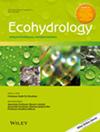The Ecohydrology of Coastal Ghost Forests
Abstract
Sea level rise and storm surges affect coastal forests along low-lying shorelines. Salinization and flooding kill trees and favour the encroachment of salt-tolerant marsh vegetation. The hydrology of this ecological transition is complex and requires a multidisciplinary approach. Sea level rise (press) and storms (pulses) act on different timescales, affecting the forest vegetation in different ways. Salinization can occur either by vertical infiltration during flooding or from the aquifer driven by tides and sea level rise. Here, we detail the ecohydrological processes acting in the critical zone of retreating coastal forests. An increase in sea level has a three-pronged effect on flooding and salinization: It raises the maximum elevation of storm surges, shifts the freshwater-saltwater interface inland, and elevates the water table, leading to surface flooding from below. Trees can modify their root systems and local soil hydrology to better withstand salinization. Hydrological stress from intermittent storm surges inhibits tree growth, as evidenced by tree ring analysis. Tree rings also reveal a lag between the time when tree growth significantly slows and when the tree ultimately dies. Tree dieback reduces transpiration, retaining more water in the soil and creating conditions more favourable for flooding. Sedimentation from storm waters combined to organic matter decomposition can change the landscape, affecting flooding and runoff. Our results indicate that only a multidisciplinary approach can fully capture the ecohydrology of retreating forests in a period of accelerated sea level rise.

 求助内容:
求助内容: 应助结果提醒方式:
应助结果提醒方式:


